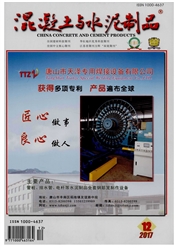

 中文摘要:
中文摘要:
研究了铜渣微粉的火山灰活性和不同掺量对低水胶比超高性能水泥基复合材料的水化热、流动度、抗折强度、抗压强度的影响规律。试验结果表明,钢渣微粉具有比较高的火山灰活性,28d的活性指数可达到87.1;钢渣微粉掺量为10%时.累积放热量达到最大;当钢渣微粉掺量大于10%时,随着掺量的增加,累积放热量随之减少;铜渣微粉颗粒近似球体.会提高极低水胶比超高性能水泥基复合材料的流动度;钢渣微粉的掺入使超高性能水泥基复合材料的抗折强度先增加后减小,钢渣微粉掺量为10%的超高性能水泥基复合材料抗折强度最高,高达25.8MPa;钢渣微粉掺量在0-20%内,抗压强度略有降低。但仍可满足超高性能水泥基复合材料强度要求。证明了钢渣微粉可作为胶凝材料制备极低水胶比超高性能水泥基复合材料的可能性。
 英文摘要:
英文摘要:
The pozzolanic reactivity of steel slag, the effects of different steel slag contents on heat of hydration, fluidity, flexural strength and compressive strength of ultra-high performance cementitious composites (UHPCC) were investigated. Experiment results indicate that the steel slag has higher pozzolanic reactivity up to 87.1 at 28 days. When 10% of the cement is replaced by steel slag powder, the fresh paste achieves the maximum of hydration heat, and the hydration heat decrease with the increase of replacing quantity of steel slag. The spherical morphology of steel slag leads to the increase of the fluidity of fresh paste. With the increase of replacement rate of steel slag, the flexural strength of UHPCC increases first then decreases, the flexural strength of UHPCC with the replacement of 10% cement can reach 25.8MPa at the highest. In addition, the compressive strength of UHPCC with the steel slag in 0-20% decreases slightly while still meets the UHPCC strength requirements, which prove the possibility of steel slag can be used as a sustainable cementitious material.
 同期刊论文项目
同期刊论文项目
 同项目期刊论文
同项目期刊论文
 期刊信息
期刊信息
